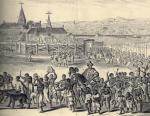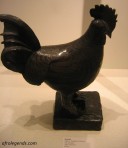
Today, I would like to tell you about Benin City, the great city at the heart of the Benin Kingdom. The city, not at all related to the present-day country of Benin, was burnt to the ground by the British who were amazed by its beauty and wealth (just like many ancient kingdoms in the Americas were burnt to the ground by Europeans). I would like to tell you about this ancient beautiful city whose art still marvels millions of people everyday in worldwide museums: Benin City.

Benin city was the capital of the kingdom of Benin (in present day Nigeria) which was founded in the 13th century by the Edo people, and flourished between the 14th and 17th centuries. Its early name was Ubinu, which later was turned into Bini, and then Portuguese called it Benin. The kingdom was ruled by an Oba or king, in a very well-structured hierarchy. Starting in the late 15thcentury, Benin traded with Europeans items such as ivory, pepper, palm oil, and cloth. From history books, it is said that the city was laid out in a sophisticated system of huge straight streets, very wide, long, and well-maintained. Houses were built in rows along the streets. These houses had covered porches to protect people from the sun or rain, as they sat outside.

The Oba governed over the entire region. Oba Ewuare, the first gold age Oba, is credited with turning Benin City into a military fortress protected by moats and walls known as the Walls of Benin. It was from this bastion that he launched his military campaigns and began the expansion of the kingdom from the Edo-speaking heartlands. At its peak, the empire extended from Onitsha in the east, through the forested southwestern region of Nigeria and into the present-day nation of Ghana.
The state developed an advanced artistic culture especially in its famous artifacts of bronze, iron and ivory. The Benin artists mastered the art of bronze, iron, and sculpture. The most well-known artifact based on Queen Idia, popularly called the FESTAC mask, currently resides at the Metropolitan Museum of Art (MET) in New York City.

The Punitive expedition of 1897 was a military excursion by a British force of 1,200 under Admiral Sir Harry Rawson that captured, burned, and looted the city of Benin, bringing to an end the West African Kingdom of Benin. During the conquering and burning of the city, most of the country’s treasured art, over 3,000 pieces of art work, including the Benin Bronzes, was either destroyed, looted or dispersed. The British used one of their favorite tactics to burn the city to the ground: deception – they claimed that the Omo n’Oba Ovonramwen had breached a treaty (they wanted to annex Benin Kingdom as a British protectorate, and the Oba refused to sign). When the Oba realized that the treaty presented to him was a deceptive ploy to conquer his people, he issued an edict barring all British officials and traders from entering Benin territories. Since the consul general of the Oil River Protectorate authorities considered the ‘treaty’ legal and binding, he deemed this a violation of the treaty and a hostile act. Repeated attempts by the British to invade the Benin Kingdom followed, but without success. In 1896, the major Phillip tried to attack and seize the city of Benin without approval from his superiors.

However, the Benin noblesmen decided to send a strike force to destroy the invaders (just normal, if an invader comes to burn and loot your place, you strike to defend yourself). Only two British soldiers survived. This came to be known as the ‘Benin massacre’ in the British press (In the eyes of the British crown, this was the perfect excuse to attack the Benin kingdom). On January 12, 1897, Rear-Admiral Harry Rawson, commanding the squadron at the Cape of Good Hope was sent by his high commandment to capture the Oba of Benin and destroy Benin City. The operation was named ‘Benin Punitive Expedition.’ The invasion of Benin kingdom was launched on February 9, 1897. The field commanders were instructed by their commander-in-chief to burn down all Benin kingdom’s towns and villages, and hang the king once captured.

On February 17, 1897, Benin City fell to the British. On that fateful day in history, the city of Benin lost its independence, its sovereignty, its Oba (king), its beauty, and its control of trade. The city was looted and burnt to the ground. The ivory at the palace was seized. Nearly 3000 of the famous Benin Bronzes and other valuable works of art, including the magnificently carved palace doors, were carried back to Europe. The Oba was exiled to Calabar with his two wives, and subsequently died there. Today, every museum in Europe possesses art treasures from Benin.
To read a detailed account of the destruction of Benin city, check out the Benin Massacre page. Edoworld.net tells about the Benin Kingdom and its magnificence, as well as its destruction. The art pieces shown on this page are all exposed at the MET, and pictures were taken during my visit to the MET. Watch and enjoy a quick history of Benin City.


Pingback: Why the name: Lagos? | African Heritage
Pingback: Why the Name: Casablanca? | African Heritage
Pingback: When Looted Art is returned to Nigeria | African Heritage
Reblogged this on African Heritage.
LikeLike
My love Africa , we still great!!!
LikeLike
Pingback: Scarification: an ‘Ancient’ African Tattoo Culture – Gatingo Africa Magazine
That is just so sad that Benin City was asunder. All of that history was great, but it was taken away. They should get the artifacts and try to renovated whatever they can.
LikeLike
Yes… I agree that their history should be returned to them.
LikeLiked by 1 person
Sure. They can start with their artwork and then get everything else that’s salvaged.
LikeLike
Pingback: Scarification: an ‘Ancient’ African Tattoo Culture - Gatingo
Pingback: Scarification: an ‘Ancient’ African Tattoo Culture - Gatingo Africa
Pingback: Scarification: an ‘Ancient’ African Tattoo Culture - My Blog